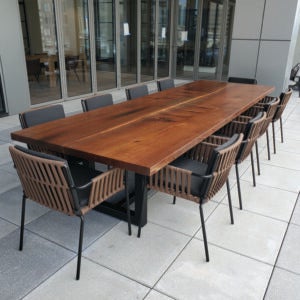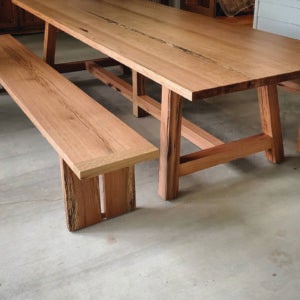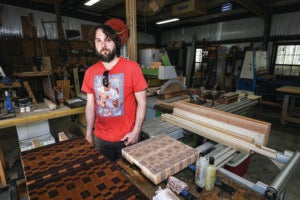By Julie Mabus
Photos by Bruce Newman

John Haltom in Oxford, Miss. on Thursday, March 28, 2024. (©Bruce Newman)
The roads were clear, but traces of snow lay scattered among the pines and hardwoods lining County Road 102. Charred remains of the old College Hill Presbyterian Church glistened in the morning sun with resistant ice patches slowly giving way to melting puddles of muddy earth.
I was searching for the home of Mississippi-raised John Haltom, an outdoorsman, woodworker, husband, and father raising his family on a beautiful country road in the bowels of northern Lafayette County. I found his driveway and slowly drove past the homeplace. An industrial-looking building sat at the back of the property where neatly stacked wood stood drying in the sun. Well, it wasn’t precisely wood; it was a vertically sliced tree lying on its side. Each plank was edged with its protective bark, and the longitude of its grain was soaking up the midwinter sun.
John was ready for me. “Outlaws and Armadillos” music (more on that genre later) set the mood in his workshop. He motioned for me to sit on an old ice cooler and positioned himself on a stack of drying walnut planks. An exquisite conference table-in-waiting was poised as if to take notes.
I took a minute to examine the space, some forty by sixty feet. The room was immaculate, everything in its place. Various woodworking equipment with different functions stood at attention. Hand tools were organized, and the floor was clear of chips and sawdust. Other massive boards of cherry or maple waited in anticipation of embodying the next table, credenza, or bench.
“This place is so clean. I’m amazed.”
John laughed. “Oh, no. It’s a mess. It drives me crazy when things get like this.”
Respect was the first thing that came to mind—respect for a sense of order, respect for the furniture he extracts from his lumber, respect for the tree that gives up its heartwood in the production of John’s art.

John’s connection with wood and its bounty likely stems from the DNA of his great-grandfather, Marvin Haltom, and his grandfather, Bob Haltom. During their lives, each owned and operated lumber mills in Mississippi.
Bob Haltom started his career as a pharmacist in Batesville after graduating from Ole Miss. But an investment opportunity led him to Roxie, Mississippi, about twenty miles east of Natchez. John’s grandfather milled pine and hardwoods from Mississippi for nearly two decades and shipped logs by train from Oregon forests. Though the elder Haltom sold Haltom Lumber Company before his grandson was born, John’s sensibilities were clearly shaped by the stories his “Papa” shared over the years.
John is the son of highly distinguished parents. Dr. Jim Haltom is a pulmonology and immunology specialist in Jackson, starting his training at the world-renowned National Jewish Hospital in Denver. Susan Fugate Haltom is a master gardener and author who worked hand-in-hand with Eudora Welty and for years after her death to restore Miss Welty’s Belhaven garden in Jackson to its authentic, pre-World War II splendor.
From his earliest years, John was a child of nature. Though his parents did not hunt, they recognized John’s propensity and shared their young son with friends who took him hunting. John is a skilled marksman, but the bow captured his imagination and awakened his love for woodworking.
“When I was a kid, probably around six or seven, I began reading books on bow-making and bowyers. That’s someone who makes the bow. About that time, Andy Blake, a family friend (and member of the Craftsmen’s Guild of Mississippi), took me to his land in Pocahontas. We cut a tree and processed it into six-foot lengths. However, wood has to dry for a couple of years before it can be used to make bows or furniture. Another family friend gave me some bow staves—that’s a piece of blank wood used to make a self bow.”
I had to look that one up. In a Michigan periodical, “Woods-N-Water News,” I found a quote from Gary Davis, a man who spent his life making, shooting, and hunting with self bows until he died in 2021. David explained, “They’re called self bows, not
because you make them yourself, but because they’re not dependent on anything but themselves. They’re a single stave of wood. You cannot buy the simple satisfaction of making your own bow. When you step into the woods, it’s like stepping back in time.”
John continued. “I made my first operable bow when I was seven or eight. My parents were always supportive of my interests. In our backyard, Dad buried a piece of steel in concrete and mounted a plate for a vice. I used it to carve the stave and make the bow. And Dad collects American antiques. He found antique drawknives and spokeshaves for me at estate sales.” Those are carving tools for shaping and refining the wood. “And you have to bend the wood, so we boiled water in our kitchen, using the steam to make the wood more pliable.”
As a teen, John submitted three bows to the Craftsmen’s Guild of Mississippi. After a rigorous jury process, he became the organization’s youngest member when he was 16.
Never one to follow convention, in 2002, John spent four months of his high school junior year at The Mountain School in Vershire, Vermont. Fifty students lived, worked the land, and studied together, forging memories and lifelong friendships. “Something about physical labor, working outside, working with my hands—these are the things that drive me.” The school fed those passions.
After high school, John’s college experience further fed his attachment to the land and its physical demands. He looked beyond Mississippi to the American West and found the University of Montana in Missoula. He was one of four Mississippi boys studying there at the time. John studied Native American History and wilderness classes. “I spent time on a Navaho and a Hopi Reservation. Many of the students were from local tribes.”
For six or seven years during and after college, John worked with the U.S. Forest Service’s wilderness crew in the mountains and forests of Colorado and Montana. It was physical labor, clearing and maintaining trails, and he was available to advise the public, keeping him intimately tied to the land and its immeasurable gifts.
“But I just got tired of the winters.” John returned to Mississippi and found work at a tree service company. The physical work kept him outside, but it wasn’t right. He eventually applied for and took another wilderness position with the highly prestigious Lolo National Forest in Montana. After a season with Lolo, John was pegged for management, which meant a desk. He knew that wasn’t going to work.
Sometimes, it’s a friend of a friend who sparks a change. John got a call from a connection through The Mountain School, “Come on out to Seattle, John. Let’s do carpentry.” It was just the right stimulus at the right time. John made the move and jumped headlong into contracting work and remodeling homes. “In the beginning, it was overwhelming. I didn’t know anything about it. We were framing, doing trim work, and hanging windows and doors. But some of the older men who were supervisors took me under their wings.”
In 2010, while in Seattle and in one of those twist-of-fate coincidences, John became a protégé of New Jersey-born Bob Woolworth, a supervisor at their construction company. As it turned out, Bob is also the brother of Mississippi transplant Dave Woolworth, an acoustics consultant and bass player for the Oxford-based Kudzu Kings, an alternative country and rock band.
John is a big music aficionado, leaning toward the “Outlaws and Armadillos” sound. As he explained, it combines Austin and Nashville’s music with a peppering of Willie Nelson and Waylon Jennings.
“When Bob told me about his brother, I lit up. ‘No way, I’ve heard your brother play many times.’ And I recently heard him play at Oxford Treehouse Gallery for an event there.’ Maybe the die was cast for John’s eventual return to Mississippi, but the time was not right yet.
The Universe is a funny thing. Nearly four years into his carpentry career, John fortuitously passed a furniture showroom in downtown Seattle. The company, Urban Hardwoods, sources its materials from locally damaged and salvaged trees and then hand-builds unique, upscale furniture.
Bingo! It was a perfect match. “It was a combination of my bows, my love of trees, and my carpentry.” John walked into the showroom and applied for a job.
“The company had this massive sawmill, the largest in the contiguous U.S. It had a throat capacity of seven feet in diameter. Just think about the size. For six months, I mostly sanded. I’m not sure people realize how hard and critical sanding is when you’re building furniture. And I was so happy because of the materials—walnut, English elm, American elm.”
John didn’t stop his education there. “I started independently researching joinery.” Technically, joinery is the 3,000-year-old method of using wood dowels to connect two pieces of wood. It is like an intricate wooden jigsaw puzzle that joins one hand-crafted piece to another. John found the definitive school for studying and applying the technique in Los Angeles and took advantage of the resource.
As John spoke about the topic, I remembered my own mother’s love of antiques. She taught me to look at the joinery in furniture to detect its authenticity. At one point in my life, I bought and sold antique furniture from China. The Chinese are masters at joinery, crafting their furniture without screws or nails. Instead, they use mortise and tenon joinery; it’s sort of like a hole with a wooden peg.
By around 2014, John had spent four years perfecting his craft. His life was about to take a new and exciting turn. He married his Seattle love, Katey Roe, in an intimate service at Ballard Commons Park in Seattle, and they were ready for a new place to live.
“We knew we wanted to move south. Oxford was an easy pick. It’s a small town full of music, art, and craftsmen, and the schools are great.”
Five months later, at the end of 2015, the couple made the move, and the pieces fell into place. John rented a shop in town. With help from a realtor friend, they found their perfect home in Lafayette County with plenty of land. John started with some carpentry work until he got his legs under him and was able to build the shop on their property.
John named his business Roxie Woodworks after his grandfather’s sawmill in Roxie. “Everything started happening by word of mouth. Once I built this shop, the commissions started—coffee tables, side tables, butcher blocks. I prefer walnut, but I do plenty of cherry and sometimes sycamore. Local designers got interested. Probably 25% of my business is through interior designers. Most are local, but some are out of state.” John’s brother David provided a little boost.
David studied architecture at Yale and Glasgow School of Art and now works for a national real estate development firm in Denver. But while David was with a global development company in Houston, John made a presentation to the company’s interior design team, which helped him secure some beautiful projects in Texas and California. John’s exquisite conference tables have become a favorite locally and around the country.
John’s younger brother, Scott, is an engineer at ExxonMobil in Baton Rouge. Still, many will remember Scott as a catcher for the Ole Miss baseball team when he graduated in 2010.
It’s interesting to note that Susan Haltom’s father, John Paul Fugate, played baseball for the Cincinnati Reds knothole team and later for Washington State University. He volunteered for the Marines in World War II and saw heavy action in the Pacific Theater; at one point, he was shot in the stomach but kept fighting. John proudly wears a large tattoo on his upper right arm, commemorating his grandfather’s Marine status and his heroism in the War.
Today, while John is in his shop plying his incredible trade, his wife Katey works at home for a small company that plans events for Microsoft and Google. They are raising a boy and a girl. He beamed, “My six-year-old is learning to use a bow I made fifteen years ago.”
We walked into a separate room in the back of his shop, where a table waited for its next round of sanding and varnishing. A dark seam ran the length of the piece. “That’s the crotch. It’s where the branch grows out of the trunk. I took it and split it lengthwise along the crotch line, then flipped the pieces and reassembled. It’s kind of like a yin and yang thing.”
As I was preparing to leave, I mentioned The Hidden Life of Trees, an excellent book about the heart and soul of trees. John chimed in, “Oh, listen to this. My friend Bill Simmons, a Nashville music manager who recently moved to Oxford, just called me about a hundred-and-twelve-year-old pecan tree standing eighty to ninety feet on a farm outside of Chrystal Springs. It’s dy

John Haltom in Oxford, Miss. on Thursday, March 28, 2024. (©Bruce Newman)
ing, so they’re cutting it down today. It’s heartbreaking, but the Ethridge family, Anne Ethridge, wants me to salvage the wood. That’s the beauty of it. Its life won’t be truncated. It will live on.”
The body of that magnificent pecan tree is now drying peacefully at the Ethridge farmhouse owned by Nora and Tam Ethridge, Anne’s parents. Anne is a highly respected cinematographer in Los Angeles, but she maintains close ties with her family and her Mississippi land.
For over a century, that tree provided cover and shelter for wildlife, shade for family picnics, and sustenance to any animal lucky enough to reach its fruit. But Anne recognized its life, as she knew it, was over. She was also sensitive enough to put its trunk and branches in the hands of a master craftsman. John will give the beloved tree a second life. That’s what he does. That’s who he is.








